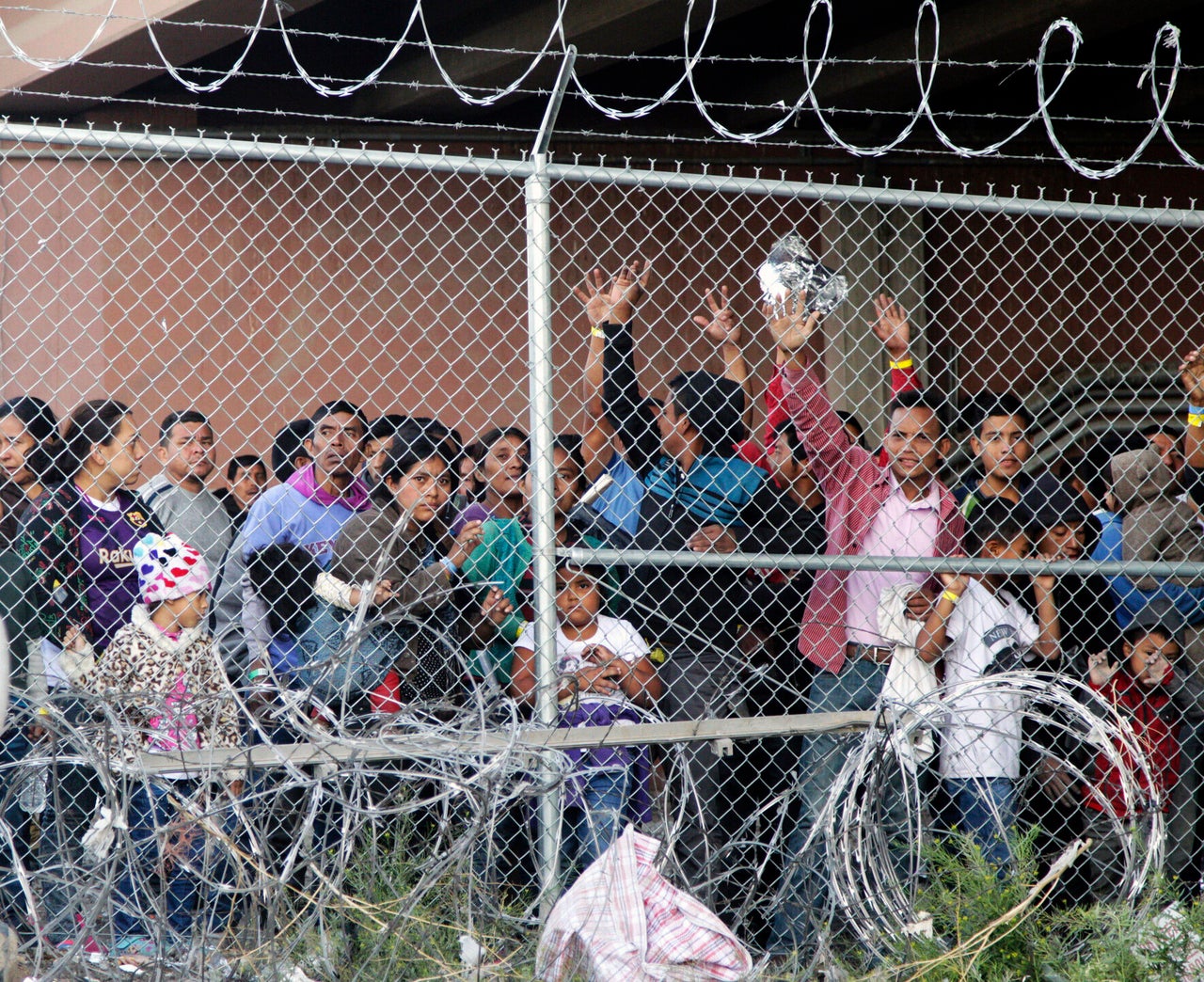Five years ago, Kris Kobach, Kansas’ former secretary of state, announced on Fox Business Network that, in order to quickly deport undocumented immigrants seeking asylum in the United States, the Trump administration would need “camps.”
Or, as he also put it, “processing towns.”
The U.S. government owns “thousands of empty mobile home trailers,” Kobach told host Lou Dobbs, and it should “deploy them to border cities and create processing towns that are confined.” People who cross the border seeking refuge in the United States, he said, should be detained there until their claims are rejected, then promptly expelled from the country.
Kobach, then the general counsel of a private border wall-building effort — two former leaders of which later went to prison for defrauding donors – was a lonely voice at the time. But in the years since, the Trump wing of the Republican Party has come around to his point of view.
Key allies and advisers aren’t mincing their words: In order to carry out Trump’s mass deportation agenda, the United States will need enormous prison camps for immigrant families, part of an effort to deport millions of people at a record pace.
The mass deportation operation will be a “bloody story,” Trump said last weekend. And key advisers have promised a historic infrastructure project to churn people out of the country.
The camps will be built “on open land in Texas near the border” and should have the capacity to house as many as 70,000 people, which would double the United States’ current immigrant detention capacity, Stephen Miller, the main point man on immigration in Trump’s White House, said last year. In multiple interviews, Miller has gleefully described daily flights out of the camps to all corners of the world, an undertaking he said would be “greater than any national infrastructure project” in American history.
“Trump comes back in January — I’ll be on his heels coming back, and I will run the biggest deportation force this country has ever seen,” Thomas Homan, who served as acting director of Immigration and Customs Enforcement during the Trump administration, said in July at a conference for Trump-aligned conservatives.
“They ain’t seen shit yet,” Homan said. “Wait until 2025.”
Eisenhower 2.0
Trump himself, as usual, has stayed away from the details of his plan to deport more than 10 million people, and his campaign didn’t respond to HuffPost’s questions about specific policies.
Instead, the campaign’s national press secretary, Karoline Leavitt, said in a statement: “President Trump will restore his effective immigration policies, implement brand new crackdowns that will send shockwaves to all the world’s criminal smugglers, and marshal every federal and state power necessary to institute the largest deportation operation of illegal criminals, drug dealers, and human traffickers in American history.”
Trump has frequently invoked former President Dwight D. Eisenhower ― whose administration infamously oversaw a massive, deadly deportation program named after a slur, “Operation Wetback” — as a model.
That program, launched in 1954 to push undocumented migrants into Mexico, has been a Trump hobbyhorse for years. In 2016, CNN’s Jake Tapper pressed Trump to respond to critics who called it a “shameful chapter in American history”; Trump countered by saying, “Some people think it was a very effective chapter.”
Eisenhower “did a massive deportation of people,” Trump told Time in April this year. “He got very proficient at it.”
“I will run the biggest deportation force this country has ever seen … They ain’t seen shit yet. Wait until 2025.”
– Thomas Homan, former acting director of Immigration and Customs Enforcement during the Trump administration
Eisenhower’s deportation effort resulted in the expulsion of more than 1 million people, according to a government report. That tally is likely exaggerated, though, and includes a significant number of people who today might be said to have “self-deported” ― that is, they left the country on their own rather than face arrest or deal with court proceedings.
Government records detail a militaristic operation using trucks, jeeps and planes. The government conducted naval deportations on cargo ships that a congressional investigation later compared to cramped slave ships — and which led to highly publicized drownings. Law enforcement agencies, from local police up to the federal Border Patrol, pitched in on mass sweeps of industrial areas and immigrant-dense neighborhoods.
Press clippings from the time noted numerous camps were used to house people awaiting deportation. The Los Angeles Times described one such “concentration camp” as “a wire-fenced security camp” capable of holding 1,000 people in Elysian Park. Within a few years, the same area would host Dodger Stadium. Subsequent coverage included a photo of a 10-month-old in her mother’s arms — “youngest internee,” the caption reads — and a 1-year-old American citizen being deported along with his family. Other stories referred to “human freight” being shipped back to Mexico.
“I have seen mothers deport[ed] and leave on this side their nursing babies,” one South Texas resident reportedly wrote to the attorney general. “What is wrong with this country any way?”
The nature of immigration, and immigration law, was much different in the ’50s, when the U.S.-Mexico border was more porous and seasonal migration was common. But Trump and the modern Republican Party have embraced the Eisenhower operation’s purge of immigrants: At the Republican National Convention, scores of people held up “Mass Deportation Now!” signs distributed by organizers, and this year’s GOP platform promises “the largest deportation operation in American history.”

Andrew Harnik via Getty Images
Aspects of Trump’s plan would almost certainly be challenged in court. But the scope of Republicans’ ambitions is nonetheless startling.
The GOP platform calls for immigration arrests executed in cooperation with local police and “massive portions of Federal Law Enforcement” who’ve been shifted from their normal work over to immigration enforcement, alongside “thousands of Troops” who would be transferred to the border. The platform also calls for invoking the Alien Enemies Act, an 18th-century law that gives the president broad powers to deport people from hostile nations. Trump has reportedly considered using the law as a pretext to deport people whose countries of origins contain drug cartels and gangs, accusing them of invading the United States.
‘Large-Scale Staging Grounds’
If Trump and his team are serious about deporting every undocumented person in America, they’ll need a place to put them first.
Despite Trump’s hatred for “catch-and-release”— the fishing term he uses to describe the policy of releasing immigrants from custody as their legal cases proceed — the simple fact is there was, and is, nowhere near enough detention space available to incarcerate everyone Trump wants to deport.
Immigration officials struggled to keep up with the Trump White House’s demand for space to detain immigrants in deportation proceedings, according to records obtained by NPR. Trump increased the number of proceedings initiated against undocumented immigrants each year — but that didn’t mean that all of those immigrants were actually forced to leave the country. Instead, it just left behind a huge backlog of cases for his successor.
Over the course of his first term, U.S. migrant detention expanded to new heights, part of a decades-long trend of putting more and more people behind bars.
Miller was perhaps the most influential voice in Trump’s ear on immigration, including on Trump’s infamous family separation policy and his ban on immigrants from several Muslim-majority countries.
And he has been clear about his plans for Trump’s next term in office.
Rather than simply trying to block immigrants and asylum seekers from entering the country in the first place, as Texas Gov. Greg Abbott (R) is trying to do with his militarized “Operation Lone Star,” Miller envisions a “detain-and-remove strategy,” as he told Charlie Kirk last September. Such a strategy would involve local, state and federal law enforcement, as well as the U.S. military, he said, including “deputized” National Guard soldiers.
“You would need to switch to indiscriminate, or large-scale, enforcement activities ― involving, basically, going into any place where there’s known congregations of illegals and holding everybody on sight, determining who’s there illegally, and then taking people who are there illegally into federal detention,” he said on “The Clay Travis and Buck Sexton Show” in November.
The detention facilities Miller envisions would be massive. He’s described them as “large-scale staging grounds near the border, most likely in Texas,” and “an extremely large holding area” that “could hold upwards of 50, 60, 70 thousand illegal aliens.”
The camps would have “constantly” operating runways, Miller said separately in November, with a packed schedule of lights — “probably military aircraft, some existing DHS assets” — shipping deportees around the world.

Miller isn’t the only one thinking about this. Former Trump officials told NBC News in July that the mass deportation effort would likely involve the Pentagon, which “would be asked to participate in either setting up detention camps or relocating migrants to foreign military bases.”
The Interior Department would be asked to provide federal land for deportation sites, the report added, describing interviews with the former officials. The Department of Justice and Department of Health and Human Services would also be involved, according to the report — the latter because it’s the government agency that currently deals with unaccompanied children.
‘Like Watching “Schindler’s List”’
Trump has not denied or distanced himself from any of this. Shortly after he praised Eisenhower’s “massive deportation” operation to Time, Trump said he would use the National Guard to round up people — and “if they weren’t able to, then I’d use the military.”
Without naming him, Trump also embraced Miller’s theory that undocumented people are actually enemy invaders, and therefore fair game to be deported by the military. And, pressed by his interviewer on the need to build new migrant detention camps, the former president dodged the question before saying, “I would not rule out anything.”
“It’s possible that we’ll do it to an extent but we shouldn’t have to do very much of it, because we’re going to be moving them out as soon as we get to it,” Trump said.
On this point — that massive camps won’t be necessary, because the deportations will happen very quickly — Miller and others with experience in the Department of Homeland Security disagree.
“If a deportation team goes to a particular house and arrests an illegal alien family — so, say, a mother, a father, and four children — there’s not just a plane on a tarmac that’s 10 minutes away ready to take them,” Miller told Kirk.
Rather, Miller said, “you need to then build massive staging facilities” to hold people until they’re shipped out of the country.
Other Homeland Security veterans agree with that assessment, even if they’re less giddy about it.
“The nightmare becomes obvious,” Thomas Warrick, a former DHS deputy assistant secretary for counterterrorism policy, wrote in The Hill Thursday. “A second Trump administration could detain hundreds of thousands of people, but it does not have the ability or the capacity to move them out of the country as fast as ICE, the National Guard and local law enforcement can bring them in. Expect to see families behind barbed wire in overcrowded camps, desperate U.S.-citizen children looking for missing immigrant parents, and U.S. citizens swept up in immigration raids.”
To get a sense of what future deportees might find in these camps, just look to historic conditions in immigration detention ― particularly at processing centers near the border, where migrants are sent after being arrested by Border Patrol.

In 2019, during a period of more frequent migration, the government erected tent cities to detain new arrivals. Conditions were poor. At one point, government lawyers argued that the administration wasn’t required to provide soap to children. Squalid living arrangements and dangerous overcrowding were common.
At an El Paso Border Patrol facility, border agents told government investigators that “some of the detainees had been held in standing-room-only conditions for days or weeks.” Separately, investigators observed detainees standing on toilets “to make room and gain breathing space.” Multiple children died after being detained while entering the United States, including several who died from the flu.
“The way they were treated in the facilities was horrific, horrific. Total medical neglect,” the medical director of a non-governmental migrant shelter near the border told HuffPost recently, recounting people they treated who’d passed through the processing centers in late 2018 and 2019. “It was like watching ‘Schindler’s List.’”
America Moves Right
Perhaps most troubling to activists and advocates concerned with migrants’ rights is the rightward shift both parties have taken on the border in recent years.
After all, former President Barack Obama removed more people from the country in each of his two terms than Trump did in his one term, earning himself the nickname “deporter-in-chief.”
There are some caveats to that statistic, though. For one thing, Trump dramatically reduced legal immigration. For another, the COVID-19 pandemic reduced the number of people arriving at the border, both because fewer people made the trip to the United States and because Trump cited the pandemic to invoke a rule called Title 42, which allowed Border Patrol agents to turn away even those seeking asylum.
The Trump administration also created the so-called “Remain in Mexico” policy — formally called the “Migrant Protection Protocols” — to force certain migrants seeking asylum to await their court dates south of the border, frequently in dangerous and unsanitary conditions. Trump has said he would pursue this policy again as president.
President Joe Biden has opened legal pathways for migrants seeking to enter the United States, and the overall number of border crossings during this presidency has been much higher than during the Trump administration — though Biden has also removed far more people from the country than Trump did.
Biden has also recently dramatically limited asylum rights at the border — echoing some of the Trump administration’s legal strategies — by placing new restrictions on the ability to pursue asylum that are triggered on the number of unauthorized crossings per day. The policy prevents “countless” asylum seekers from exercising their right to seek safe haven in the United States, an ongoing lawsuit from immigrant rights groups alleges.
Since Biden implemented that asylum cap, the Kino Border Initiative, a migrant aid program with locations in the United States and Mexico, has received hundreds of would-be asylum seekers at its Mexican clinic who were turned around and expelled back into Mexico at the U.S. border.
“For the last eight years or so, we have been consistently — with different policies — blocking people’s access to asylum,” Pedro De Velasco, the group’s director of education and advocacy, said of U.S. authorities.
Vice President Kamala Harris, the Democratic nominee for president, has played up her experience as a “border state prosecutor” in campaign ads, a sign she’s likely to continue Biden’s more restrictive border stances. And, like Biden, she supported a bipartisan border bill that would have expanded some legal immigration pathways while also limiting asylum rights.
Still, there’s little doubt that a return to Trump would shift U.S. immigration and border policy even further to the right. Project 2025, an ideological handbook for a second Trump term authored by scores of former Trump administration officials ― though technically not part of the GOP candidate’s campaign platform ― offers hints at what could be to come.
On top of laying out plans to severely limit legal migration, the Project 2025 playbook offers several steps to weaken the protections offered by “sanctuary cities,” which, broadly defined, limit local police departments’ ability to cooperate with federal immigration authorities. Those sanctuary policies are a major reason Trump wasn’t able to deport as many people as Obama.
Project 2025 calls for a nationwide detention standard that “allow[s] the flexibility to use large numbers of temporary facilities such as tents.” It also reiterates a goal of Trump’s first term — ending the Flores Settlement Agreement, a 1997 consent decree that places limitations on the detention of migrant children.
Put together, the overlapping arrest, imprisonment and deportation operation imagined for a second Trump term would, like Miller has said, be a historic feat of logistics — and, potentially, a new frontier in cruelty. And there appears to be plenty of other plans being developed behind the scenes.
Russ Vought, who was director of the Office of Management and Budget during Trump’s presidency, was a key co-author of Project 2025. He was also policy director of the Republican National Convention’s platform committee. And he’s in line for a high-ranking post if Trump wins a second term.
He recently told undercover reporters that he was working on about “350 different documents” full of plans for the next administration — including on mass deportations.
“You may say, ‘OK, all right, DHS, we want to have the largest deportation,’” Vought said in a secretly recorded meeting. “What are your actual memos that a secretary sends out to do it? Like, there’s an executive order, regulations, secretarial memos. Those are the types of things that need to be thought through so you’re not having to scramble or do that later on.”
The plans won’t be public, Vought said — but rather, “very, very close hold.”
Support Free Journalism
Support HuffPost
Already contributed? Log in to hide these messages.







